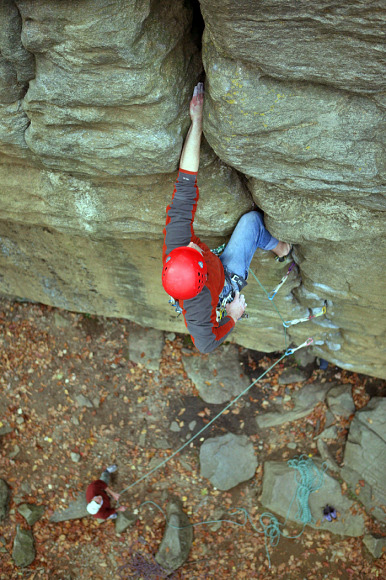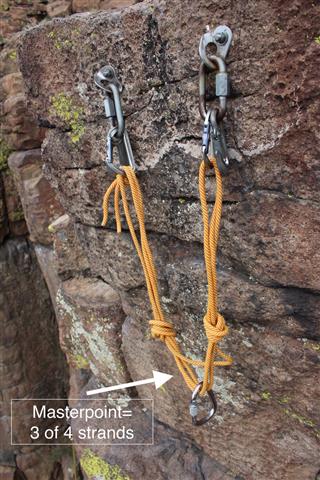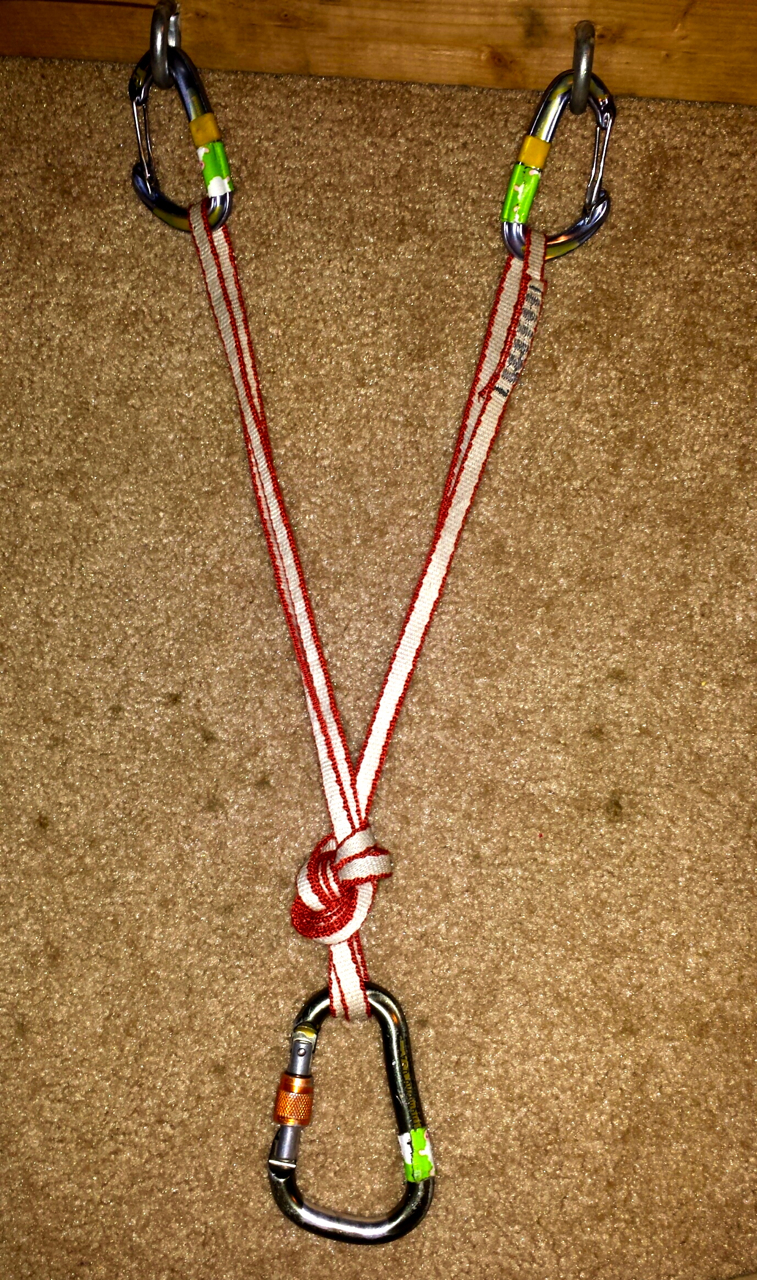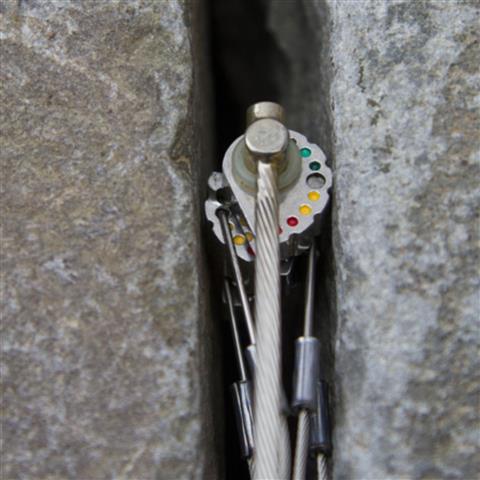Some Tips on Traditional (Trad) Lead Climbing
Introduction
This represents a small number of tips among a vast knowledge base you need to trad lead climb and is no means a substitute for learning this hands-on with an experienced instructor. It takes extensive experience (years) before you are a competent trad lead climber.
Anchor the belayer
Most of the time you will want your belayer to be anchored on the first pitch. The only exception is if the rock is of poor quality or the protection minimal and you want the dynamics of pulling your belayer off the ground during a fall to minimize the force on the protection. Obviously you will want your belayer to be anchored once off the ground on a multi-pitch.

Properly anchored belayer.
Make sure your initial ground anchor is as close to the cliff as possible so you minimize the amount of slack in the rope and keep it running as straight up as possible to eliminate the “zipper effect.” This is the nasty phenomenon in which protection pieces are pulled out one by one when a climber falls, due to the upwards, sideways, or otherwise unanticipated direction of force being exerted on the protection, rather than the expected downward direction. The zipper effect can be eliminated by standing close to the cliff, by properly placing the first protection so that it will absorb an upward force, and by utilizing the proper length slings to keep the rope running straight. As a rule of thumb, always extend your slings especially when placing passive pro.
. 
Improperly placed protection that can cause the zipper effect.

Belayer too far from cliff and too far to the left. Note
direction of pull on gear.
Building Anchors
There are whole books written on building anchors. Climbing Anchors by John Long is the best known. So this tip sheet can not dent the knowledge required. There are numerous acronyms for remembering everything required for a solid anchor. SERENE (Solid, Equalized, Redundant, No Extensions) is one. Others are LEADSTER, ERNEST, SECURE, NERDSS, and on and on. Regardless of the acronym the anchor must have (preferably) three pieces of bomb proof protection that are equalized, be redundant, and be able to hold forces from multiple directions. For example if the leader falls the belayer is pulled up exerting an upward force. You must realize that there are few if any perfect anchors. You need to make the best compromise given with what you have to work with.
A cordelette is the quickest most efficient way to build a trad anchor. A cordelette is typically 20 ft of 6-7 mm nylon cord tied in a loop with a double fisherman knot, or 5.5 mm Spectra cord tied with a triple fisherman knot, or a 8-10 ft 8-10mm sewn Dyneema cordelette. An alternative is a (Mountain Tools) Web-o-lette (a 10 ft spectra sling with loops sewn in each end).

Web-o-lette



Properly equalized redundant anchors utilizing a cordelette in two different configurations and a 2 ft sling.
Placing Protection
Lead protection must adhere to two rules: gear
should be
able to hold a fall, and it should keep the leader from hitting ledges
or the
ground. You should be confident enough in your gear that
you can climb above
it without fear allowing you to climb at your limit instead of holding
back due
to uncertainty.
Placing
protection requires lots of practice to quickly judge the right kind
and size
of gear needed, an asset when hanging from one arm. Protection
should always
be oriented in the direction of the force (usually downward).

Metolius cam properly cammed and orientated in vertical crack.

CCH Alien properly cammed and orientated in horizontal crack.

Properly placed nut for downward force. In many cases you also want to use a full 2 ft sling on nut
placements to ensure a downward pull on the gear. If in doubt extend
the sling.

Optimally nuts should contact the rock evenly on both sides.

Properly cammed Black Diamond Camalot
An active cam is optimally placed if the cams are retracted 50 to 90 percent and evenly contacting the rock. If you retract it more than 90 percent your second might not get it out and it is the leader’s fault. If you retract it less than 50 percent it has less holding power. If an active cam is placed in a horizontal crack then the two outside cams should be oriented so that they contact the bottom of the crack first.
It is most important to get lots of protection in low on the climb to avoid potential ground fall. Also once you are leading above your anchor on a multi-pitch you must immediately get protection in to minimize the potential for a Factor 2 lead-fall. This is the most critical point in regard to minimizing the potential lead-falling forces. Simply put, a Factor 2 fall occurs when a lead climber who has placed no protection falls past the belayer (two times the distance of the rope length between them). Often clipping the highest piece of a solid anchor is the best option, or even better, placing a piece immediately above the anchor. These are both actions which will result in lowering the potential falling forces. More gear than less is better in the first few moves above the ground or a multi-pitch anchor, especially if the anchor is less than ideal or if the likelihood of a fall is significant as lower falling forces also better enable the belayer to maintain a grip with their brake hand.
Clipping Biners
Back clipping is a common mistake of inexperienced climbers. The rope should always be clipped so it runs from the rock out of the biner toward the leader.

Illustration of how an incorrectly “back clipped” biner can become
unclipped.
Additionally the biner/rope should always be positioned so that it will hit the solid axis of the biner versus the gate during a fall. This can be is caused by the climber traversing at an angle above the biner. To avoid this make sure the gate is facing the opposite direction that you are traversing. Remember to face the spine of the carabineer towards the line of the route. "Spine towards the Line." A quick way to fix this is by flipping the biner upside down so the gate is opposite the side you are traversing.

Don't do this! The gate should be facing the opposite direction of the traverse to prevent the potential for unclipping. Quick fix is to flip the biner upside down.
And another tip on biners: be careful that the
biner is not
placed in the position where it will strike a protrusion and open the
gate as
below.

And one more biner trick: Most leaders rack each active cam on an individual biner. This gives you an extra biner when you attach a sling to a (placed) cam. If I’m extending the sling I always clip the sling to the biner on the cam and clip the rope through both biners that are on the sling. I then flip one of them in the opposing direction. I will also sometimes do this on a cam without an extended sling if it is a dicey spot and I am solely relying on that gear. The likelihood of the both of the biners coming unclipped during a fall is now infinitesimally small.
|
|
|
Rope clipped through two opposed biners
A Word on Gear
Trad climbing is gear intensive and which brand/type cams, nuts, biners, etc. to use is highly subjective. Many climbers tend to use the type/brand gear they were taught on by their mentors. A few things that are unique to trad climbing are not subjective.
Slings: Use 2 ft slings vice quickdraws. Quickdraws are occasionally used but are primarily for sport climbing. Two foot runners can be shortened to the length of a quick draw and easily extended for wandering routes, roofs, and corners by just unclipping any two of the slings with one-hand. As a rule of thumb, always extend your slings especially when placing passive pro. You will want to carry 10-12 two foot slings with two biners on each and one 4 ft sling.

Method used to shorten 2 ft sling to make a “quickdraw.”
Carabiners: Bent-gate biners are generally not used in trad climbing. They increase the potential for a biner to unclip itself in a fall. They are used by sport climbers on quickdraws.
Shoes: Shoes should be comfortable for long all-day multi-pitch routes vice gym slippers that have to be taken off on every belay ledge because they hurt so badly.
Emergency gear: Trad climbers should carry an “Oh shit” biner containing two prussiks, a small folding knife, whistle, and two rap rings. All required for emergency use. A ten foot length of webbing carried in your pack is handy to build raps for forced retreats.
Packs: Packs are normally worn on long multi-pitch routes where you will need to carry a rain gear, headlamp, shoes, water, and food. You want to carry a small pack designed for climbing that sits up high on your back out of the way of your harness. An example is the Black Diamond Bullet pack.
Helmets: Helmets should be worn when trad climbing. No explanation needed.

